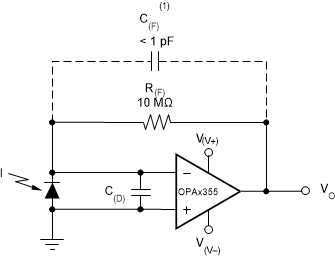JAJSFB5E March 2001 – April 2018 OPA2355 , OPA3355 , OPA355
PRODUCTION DATA.
- 1 特長
- 2 アプリケーション
- 3 概要
- 4 改訂履歴
- 5 Device Comparison Table
- 6 Pin Configuration and Functions
- 7 Specifications
- 8 Detailed Description
- 9 Application and Implementation
- 10Power Supply Recommendations
- 11Layout
- 12デバイスおよびドキュメントのサポート
- 13メカニカル、パッケージ、および注文情報
パッケージ・オプション
メカニカル・データ(パッケージ|ピン)
サーマルパッド・メカニカル・データ
発注情報
9.2.1 Transimpedance Amplifier
Wide gain bandwidth, low input bias current, low input voltage, and current noise make the OPAx355 series a preferred wideband photodiode transimpedance amplifier family. Low voltage noise is important because photodiode capacitance causes the effective noise gain of the circuit to increase at high frequencies.
The key elements to a transimpedance design, as shown in Figure 31, are the expected diode capacitance (C[D]), which must include the parasitic input common-mode and differential-mode input capacitance (4 pF + 5 pF), the desired transimpedance gain (R[FB]), and the gain-bandwidth (GBW) for the OPAx355 family (20 MHz). With these three variables set, the feedback capacitor value (C[FB]) controls the frequency response. C[FB] includes the stray capacitance of R[FB], which is 0.2 pF for a typical surface-mount resistor.

NOINDENT:
C(FB) is optional to prevent gain peaking. C(FB) includes the stray capacitance of R(FB).